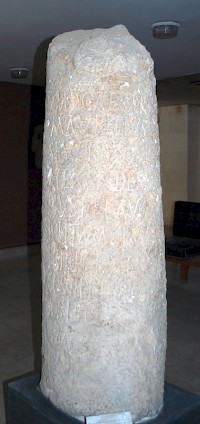Singara (Sinjar)
Q776614Singara (Greek τὰ Σίγγαρα): Roman legionary base in eastern Mesopotamia, occupied by the First Legion Parthica. The modern name is Balat Sinjar.
History
Singara is one the towns along the southernmost road from Assyria (east of the Tigris) to Syria (west of the Euphrates). Generally speaking, this is an extremely arid region, where the average daytime temperature can be higher than 50°C.note However, there are places where water can be found: Singara owes its existence to an artesian well, served by a mountain range to the north of the town called Singaras (ὁ Σιγγάρας).note Most travelers must have preferred the northern road (Nisibis Harran, Edessa, and finally Karchemish on the Euphrates).
In the Bronze Age, Singara is mentioned in the Egyptian Amarna Letters and several Assyrian sources. The Bible mentions “the plain of Shinar” (שִׁנְעָר) as a town in the kingdom of Nimrod and the site where the “tower of Babel” was built.note
The town became Assyrian at an early stage in its history and shared Assyria’s fate. It must have been conquered by the Babylonians between the fall of Nineveh (in 612 BCE) and the fall of Harran (610/609 BCE). Later, it must have been taken by the Achaemenid Persians, who had captured Babylon in 539. Two centuries later, in 331 BCE, the area was taken over by the Macedonians of Alexander the Great, and Singara became part of the Seleucid Empire, which in turn lost it to king Mithradates I the Great (r.165-132) of Parthia in the late 140s BCE. Pliny the Elder records that in his age, the first century CE, the town was the capital of "those Arabs who are called Praetavi".note Because no archaeological excavations have taken place in Singara, we know little about this period.
During the war between the Roman Empire and Parthia of 114-117 CE, Singara was occupied by Roman commander Lusius Quietus,note but abandoned when the emperor Trajan died in 117. His successor Hadrian gave up all conquests east of the Euphrates, believing they could not be defended. The Romans may have reconquered the town – albeit briefly – during the war of 161-166, but it was added permanently by the Roman emperor Septimius Severus, who campaigned in the East in 194-195 and 197-199.

During the reign of Septimius Severus, Singara became the base of the newly created First Legion Parthica, Rome’s easternmost legion. All citizens received the Roman citizenship when the town was promoted to the rank of colonia (Aurelia Septimia Colonia Singara). It minted its own coins. A milestone from c.232 CE may have something to do with the campaigns of emperor Severus Alexander in Mesopotamia against the Sasanian Persians (232-233), who had replaced the Parthians in c.224 CE.
Singara was hotly contested in the fourth century. In 343/344, the Sasanian king Shapur II (r.309-379) besieged the town, but was repelled, and in 348 defeated again, although he managed to overcome the Roman army a bit later at Hileia. In the winter of 359/360, Singara witnessed another fight between the Romans and the Persians.note The Persians arrived too swift for the Romans to send in reinforcements and this time, the Persians took the town,note which the Romans recognized in the peace treaty of 363.note Although the historian Ammianus Marcellinus informs us that the Roman soldiers were taken captive and led to Persia, they must have returned and were later stationed at Constantina, where I Parthica is mentioned in the early fifth century.
The Byzantine commander Maurice, the future emperor, captured Singara in 578.note It must have become a Persian town again, because at the beginning of his reign, the Sasanian king Khusrau II (r.590-624) sent his relatives to Singara, while his general Mebodes used it as base for a successful attack on Babylonia.note
The city had an important Christian population. Gabriel of Sinjar became the court physician of Khusrau II.